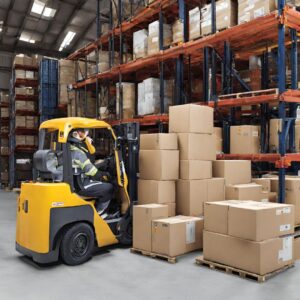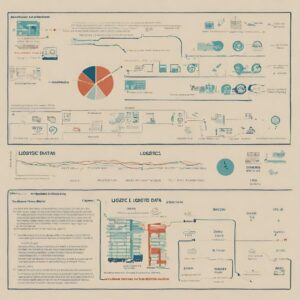Navigating the evolving landscape of logistics and delivery in today’s world is a fit every logistics industry must go through.
The logistics and delivery industry is undergoing a period of rapid transformation, driven by a number of factors, including the rise of e-commerce, the increasing demand for faster and more convenient delivery, and the need for more sustainable practices.
In this article, we will explore the latest trends, emerging technologies, and the challenges that businesses face in the evolving world of logistics and delivery.
We will also discuss innovative solutions and strategies that businesses can adopt to optimize their operations, enhance customer satisfaction, and stay ahead of the curve.
Navigating the Evolving Landscape of Logistics and Delivery: Trends in Logistics and Delivery
The rise of e-commerce: E-commerce is one of the most significant trends driving the transformation of the logistics and delivery industry.
In 2022, e-commerce sales reached $5.13 trillion worldwide, and this figure is expected to grow to $7.9 trillion by 2025.
This surge in online shopping has led to an increase in demand for last-mile delivery, which is the final step in the delivery process that takes place from the warehouse or store to the customer’s doorstep.
Customers today have high expectations for delivery speed and convenience. They want their orders to be delivered quickly, accurately, and at a time that is convenient for them.
This is driving the development of new delivery options, such as same-day and next-day delivery, as well as the use of technology to enhance the delivery experience, such as real-time tracking and delivery notifications.
Environmental concerns are becoming increasingly important to consumers, and businesses are responding by adopting more sustainable practices in their logistics and delivery operations.
This includes the use of fuel-efficient vehicles, the optimization of delivery routes to reduce fuel consumption, and the use of packaging materials that are recyclable or biodegradable.
Challenges in Logistics and Delivery
The increasing complexity of the supply chain: The supply chain is becoming increasingly complex, with more products being sourced from multiple locations around the world.
This complexity makes it more difficult to manage and optimize the logistics process, and it can lead to delays and disruptions.
1. The Labor Shortage in the Trucking Industry
The trucking industry is facing a labor shortage, which is driving up labor costs and making it difficult to find qualified drivers. This shortage is expected to worsen in the coming years, as the demand for trucking services continues to grow.
There is a shortage of qualified workers in the logistics industry, and this is making it difficult for logistics companies to meet their staffing needs.
The shortage is due to a number of factors, including an aging workforce, a lack of interest in logistics careers, and a skills gap.
This shortage is putting a strain on logistics companies, as they are struggling to find the workers they need to operate their businesses.
2. The Rising Cost of Fuel and Other Inputs
The cost of fuel and other inputs, such as labor and materials, is rising rapidly, which is putting pressure on logistics and delivery companies’ profit margins.
The cost of transportation can account for up to 70% of the total cost of logistics, so even small increases in fuel prices can have a significant impact on profitability.
In addition to fuel costs, labor costs are also rising, as there is a shortage of qualified truck drivers. This is forcing logistics companies to pay higher wages, which is further increasing their costs.
3. Demand Volatility
Consumers are increasingly demanding fast and free shipping, and this is putting a lot of pressure on logistics companies. To meet these demands, logistics companies need to be able to quickly and efficiently move goods from point A to point B.
However, demand can be volatile, and this can make it difficult to plan and execute deliveries. For example, if a popular product is suddenly released, there may be a surge in demand that can overwhelm the logistics system.
4. Regulatory Constraints
The logistics industry is subject to a number of regulations, both at the national and international level. These regulations can be complex and difficult to comply with, and they can add to the cost of doing business.
For example, the trucking industry is subject to hours-of-service regulations that limit the number of hours that a driver can be behind the wheel.
5. Last-mile Delivery Challenges
The last mile of delivery is the most expensive and time-consuming part of the logistics process.
This is because last-mile delivery involves delivering goods to individual customers, which can be difficult and time-consuming.

In addition, the last mile is often congested, as there are a lot of trucks and cars on the road. This can make it difficult to make timely deliveries.
Opportunities in Logistics and Delivery
The use of technology: Technology is playing an increasingly important role in the logistics and delivery industry.
This includes the use of artificial intelligence, machine learning, and robotics to automate tasks, optimize routes, and improve decision-making.
The rise of omnichannel fulfillment: Omnichannel fulfillment is a strategy that allows businesses to provide a seamless customer experience across all channels, from online to in-store.
This requires a high level of coordination between the logistics, warehousing, and retail operations of the business.
The growing demand for last-mile delivery services: The demand for last-mile delivery services is growing rapidly, as more and more customers are shopping online.
This is creating opportunities for new businesses to enter the market and for existing businesses to expand their offerings.
Strategies for Success in the Evolving Logistics and Delivery Landscape
Invest in technology: Businesses need to invest in technology to improve their efficiency, productivity, and customer service.
This includes the use of transportation management systems (TMS), warehouse management systems (WMS), and artificial intelligence (AI) to automate tasks and optimize operations.
1. Develop a Strong Supply Chain
Businesses need to develop a strong supply chain that is resilient to disruptions and can meet the demands of their customers.
This includes sourcing products from multiple locations, having a network of warehouses and distribution centers, and using multiple transportation modes.
2. Focus on Customer Experience
Businesses need to focus on providing a seamless and positive customer experience.
Customers are more demanding than ever before. They expect fast, reliable, and convenient delivery. Businesses that can provide a great customer experience will be able to win and retain customers. This includes:
- Offering real-time tracking: Allow customers to track their shipments in real time so they know where their packages are at all times.
- Providing flexible delivery options: Offer customers a variety of delivery options, such as same-day delivery, in-home delivery, and click-and-collect.
- Offering excellent customer service: Provide excellent customer service by being responsive to inquiries and resolving issues quickly.
- Solving customer issues quickly and efficiently.
3. Embrace Technology
Technology is at the heart of the evolving logistics and delivery landscape. Businesses that can adopt and leverage new technologies will be well-positioned for success. This includes technologies like:
- AI can be used to automate tasks, improve decision-making, and optimize routes.
- Data analytics can be used to track shipments, identify trends, and improve efficiency.
- IoT devices can be used to track the location and condition of goods in real time.
- Robots can be used to automate tasks like picking and packing.
4. Invest in Your People
 Your people are your most important asset. In order to be successful in the evolving logistics and delivery landscape, you need to invest in your employees by providing them with the training and resources they need to succeed. This includes:
Your people are your most important asset. In order to be successful in the evolving logistics and delivery landscape, you need to invest in your employees by providing them with the training and resources they need to succeed. This includes:
- Training on new technologies: Make sure your employees are up-to-date on the latest technologies that are being used in the industry.
- Cross-training: Cross-train your employees so they can be versatile and fill in when needed.
- Competitive compensation and benefits: Offer competitive compensation and benefits packages to attract and retain top talent.
5. Be Data-Driven
Data is essential for making informed decisions in the logistics and delivery industry. Businesses that can collect, analyze, and use data to their advantage will be able to improve efficiency, reduce costs, and make better decisions. This includes:
- Collecting data on all aspects of your operations: Collect data on everything from shipment times to customer satisfaction.
- Using data to identify trends: Use data to identify trends and patterns that you can use to improve your operations.
- Using data to make informed decisions:
 Use data to make informed decisions about everything from pricing to routing.
Use data to make informed decisions about everything from pricing to routing.
6. Be Agile and Adaptable
The logistics and delivery landscape is constantly changing. Businesses that can be agile and adaptable will be able to stay ahead of the competition. This means being able to:
- Quickly adopt new technologies:
- Change your processes as needed
- Embrace experimentation
Conclusion
The logistics and delivery industry is undergoing a period of rapid transformation, and businesses that are able to adapt to the changing landscape will be well-positioned for success.
By investing in technology, developing a strong supply chain, and focusing on customer experience, businesses can overcome the challenges and seize the opportunities that lie ahead.














What do you think?
It is nice to know your opinion. Leave a comment.